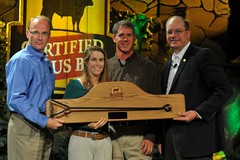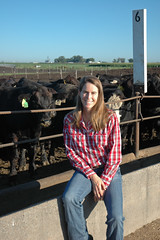A cattle feedyard is a farm like mine where cattle are fed a nutritionally balanced grain and forage based diet as final preparation for harvest. Cattle will spend 4-6 months in this stage of beef production.
CAFO is an acronym for Concentrated Animal Feeding Operation. The federal government coined the term for regulatory purposes. Any animal feeding operation with more than 1000 animal units is defined as a CAFO and is consequently regulated by the Environmental Protection Agency under the Clean Water Act.
With the ability to feed 3000 animals at a time on a forty acre tract of land, my cattle feedyard is a CAFO. The cattle are in pens of 75-175 animals. Each animal has 12-18” of space to eat at a feedbunk, and with close to 200 square feet per animal there is plenty of room in the pen for natural play behavior. One of my favorite things to do is watch my animals play. Animal psychology and behavior is fascinating to me. Interacting, caring, and training my animals brings me great joy.
As a CAFO, I am required by the Environmental Protection Agency to have a Livestock Waste Control Facility (LWCF). In fact, I just built a new LWCF last fall in order to use new technology to protect the environment. My new LWCF is lined with a very strong plastic based liner which keeps the water that drains off of my pens when it rains from leaching into the ground water while it is being stored. We temporarily store this water until our crops need it. The water that collects in my LWCF contains nutrients such as nitrogen and phosphorus which I need in order to grow crops to feed my cattle. I use this natural fertilizer to rebuild the soil nutrient content which insures the sustainability of my farm ground. We also harvest solid natural fertilizer which we use for the same purpose.
My husband farms 3000 acres so we have a lot of farm ground that requires fertilizer to maintain the soil nutrient content. By having both a cattle feedyard and a lot of acres of farm ground, our farm makes a sustainable cycle of food production: The soil grows crops which makes animal feed which is fed to animals to produce both human food and a natural fertilizer to spread back on the soil.












“Final preparation for the harvest?” Please, I’d honestly have more respect if you simply termed it as slaughter.
Hi Heather,
Thanks for taking a moment to read from my site. I am sorry if my word choice offends you—we grow and “harvest” many things on our farm: alfalfa, corn, soybeans, wheat, and cattle. Our family uses the term universally for the food products that we grow.
I have worked hard over the past couple of years to create a blog site where I can be transparent about our family’s farm and the products that we grow. I realize that there are people who think differently than my husband and I, and I respect that. In return, I ask that for future comments you maintain a respectful tone.
I believe that diversity of thought is critical to learning, however, I also think that displaying respect toward others who do not share your same ideas is vital to having a good conversation.
All the best,
Anne
i understand this is your way of farming, and that’s your prerogative. but consider this:
if you have 3000 acres, why not put the cattle out on grass instead? you could even do rotational grazing (which makes the forage super nutritious in a very short time) with half or 1/10th of labor costs compared to labor in a feedlot operation, no feed farming labor and seed costs, fertilizer automatically goes back into the ground while grazing, no medicines, or very little medicine necessary in a pasture operation; no overwhelming manure smell either! it just seems healthier, simpler, better for the environment, cows do and eat more what they would naturally do and eat outside: graze on grass and forbs; and healthier meat is produced which equals healthier humans. win-win all around.
– JG, DVM
Hello Johanna,
Thanks for reaching out to me. I decided to respond to your comment via a new blog post so I invite you to look at today’s Feed Yard Foodie post for my thoughts.
Best,
Anne
Pingback: "Give a hoot, don’t pollute" | Commonground Nebraska
Pingback: Earth Day | Dust In My Coffee